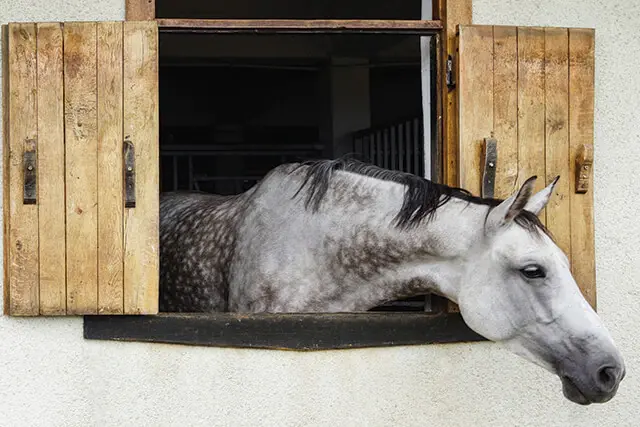Melanoma in Horses – Malignant or Benign Lumps & Bumps
Updated December 14, 2023 | By: Jamie Whittenburg, DVM

Is discovering a new lump or bump on your horse always cause for concern? The answer is that it depends.
Many skin growths are benign lesions, meaning that they are not a danger to your horse’s health. However, cancerous skin cells can grow and, in most cases, the earlier they are addressed, the better the health outcome. One type of mass that may be found on horses (especially greys) is the melanoma.
Understanding Equine Melanoma
Melanomas are skin tumors that develop from the abnormal growth of a pigment-producing skin cell called a melanocyte. They are typically raised, round, black, and firm nodules that can be found in various areas of the horse’s body. Often, they grow at a slow rate; however, it is possible for melanomas to become invasive and spread.
While they can occur in horses of all colors, grey horses are most at risk, with about 80% developing melanomas by the age of 15. When melanomas occur in a horse that is not grey, the tumor tends to be a more aggressive form of cancer.
Types of Melanomas

The two most common types of melanomas in horses are:
- Dermal melanomas: manifest as small, individual tumors
- Dermal melanomatosis: tumors merge to form larger masses
Common Areas Melanomas are Found on Horses
- Under the tail
- Around the perineum (anus)
- Near the sheath or genitals
- On the eyelids or inside the eye’s iris and retina
- The mouth or lips
- Internally on organs such as the lungs or GI tract
- On the parotid salivary glands (behind the cheek bone) and lymph nodes
The most common breeds to develop melanomas are Arabians, Lipizzans, Andalusians, and Percherons, though many grey horses of other breeds are affected.
Internal Melanomas in Horses
Though uncommon, it is possible for melanomas to form internally in horses. These masses may be initial tumors or metastatic disease. When this occurs, tumors may be found in the chest or the abdomen, as well as sometimes inside the guttural pouch.
Typically, internal melanomas are not detected by owners unless they cause issues, such as colic or difficulty breathing. Depending on the size and location, these tumors may result in illness or dysfunction and need to be addressed.


How Worried Should I Be?
Finding a new lump or mass on your horse can be frightening. But, in the case of melanoma, the prognosis is typically good. Melanomas, especially in grey horses, tend to exhibit benign type behavior. This means they rarely become locally aggressive or metastasize.
However, melanomas can become problematic. Any mass that impedes the function of your horse’s daily life will need to be addressed. These may include tumors that limit the range of motion of the legs or tail, as well as those that cause an issue with urination or defecation.
Additionally, equine malignant melanoma can be life threatening depending on what parts of the body or organs the tumors spread to.
When to Take Action Against Melanomas

There is controversy over whether melanomas are malignant or benign, but most veterinarians agree that since the tumors will continue to grow, the earlier they are treated the better.
Spending time with your horse, such as during a thorough grooming session, will help you to notice any troublesome or new skin growths as soon as possible. It is essential to regularly inspect all areas of your horse’s body, including under the tail.
Any new lump or bump should be brought to the attention of your veterinarian so they can perform a thorough exam. In some cases, it may be necessary for your vet to biopsy a mass and submit it to a veterinary pathologist for further workup.
Once a diagnosis is made, treatments will be tailored to each individual horse dependent on the diagnosis, size, and location of the mass.
Treatment Options
- Surgical removal (often the first line of therapy)
- Cisplatin (anti-tumor) injections
- Oral cimetidine (an anti-ulcer medication thought to shrink tumor size)
- Radiation
- Laser therapy and other methods
- Immunotherapy
Vaccination
Immunomodulation is an emerging science in both human and veterinary medicine. Currently, there is not an FDA approved vaccine for melanoma in horses, but there is one approved for use in dogs. The canine melanoma vaccine utilizes human tyrosinase, a protein found in high concentrations in equine melanomas. The vaccine induces a strong immune response to target the tumor.
Current Research
Studies have identified a genetic mutation related to the greying of horses, but the underlying genetic factors behind development of these tumors is still unclear. Researchers are currently working to uncover additional genetic factors involved in melanoma development in grey Connemara ponies, recognizing that it is likely a result of various genetic mutations.
Supporting Skin Cell Health for All Horses

The skin is the horse's largest organ and plays a vital role in protecting him from harmful elements like UV rays, pathogens, and chemicals. Skin cells maintain this defense mechanism through continuous growth and division. However, genetics and immune system imbalances can lead to irregular skin cell growth. So, owners should be vigilant in monitoring and addressing skin issues as soon as possible, especially with grey horses and those with compromised immune systems.
Supplements That May Support Skin Health
Certain ingredients in supplements for horses may promote immune health and normal skin cell growth, fight damaging free radicals, and produce a beautiful coat from the inside out.
- Astaxanthin: The powerful antioxidant astaxanthin may enhance the skin’s response to oxidative stress from UV damage.
- Astragalus Root: An adaptogen known for its ability to promote a healthy inflammatory response and support normal immune function during times of oxidative stress.
- Bitter Melon Leaf Extract: This antioxidant extract can assist in mitigating the effects of UV damage and may regulate melanin production in the skin.
- Green Tea Leaf: Green tea leaf extract contains the beneficial polyphenol EGCG which has been studied for its anti-inflammatory and antioxidative properties, along with its capability for inhibiting skin damage caused by UV radiation.
- L-glutamine: A precursor for the amino acid glutathione, L-glutamine is an antioxidant that may suppress abnormal cell activity.
- Omega Fatty Acids: A balanced ratio of omega-3 and omega-6 fatty acids has positive effects across many systems in the body, including skin, respiratory, joints, immunity, and others. While fresh grass contains omega-3s, you can also supplement with omega fatty acids sources like flaxseed, chia seed, and fish oil.
- Spirulina: A blue-green algae that aids in maintaining homeostasis within the body by balancing the elimination of harmful pathogens while safeguarding healthy cells.
- Vitamin E: This fat-soluble vitamin is an antioxidant that supports cellular health and the normal functioning of muscle and nervous tissue. Vitamin E must be supplied by the horse’s diet. While vitamin E is found in fresh pasture, its levels begin to decrease once the grass is cut for hay. Therefore, horses without access to fresh pasture may benefit from supplemental vitamin E.
Keeping a Watchful Eye

In most cases, the prognosis for a horse with melanoma is good. All masses should be evaluated by a veterinarian as soon as they are found and treated appropriately. Early treatment of these masses is key.
Some indicators of a poor prognosis include longstanding, untreated tumors, large tumors, and tumors in areas of the body that impede function in some way. Internal melanomas and those that have metastasized can be problematic as well.
When monitoring skin growths on your horse, it is helpful to keep a journal that lists the location of all lumps and bumps, along with dates noticed and testing results. Pictures of the area can be very helpful too as they make it easy to track growth and size over time. Many vets recommend that owners conduct a once-monthly exam of their horse during grooming to ensure new masses are not missed.
About the Author

Dr. Jamie Whittenburg has been a practicing veterinarian for over 17 years and has dedicated herself to improving the lives of animals and protecting the human-animal bond. She is the owner of Kingsgate Animal Hospital in Lubbock, Texas.
Graduating from Kansas State College of Veterinary Medicine in 2006, Dr. Whittenburg has enjoyed working with countless horses and their owners. In addition to practicing veterinary medicine, she has been a freelance veterinary medical writer for over 4 years. Through her writing, Dr. Whittenburg aims to provide in-depth, timely, and valuable knowledge to all horse owners.